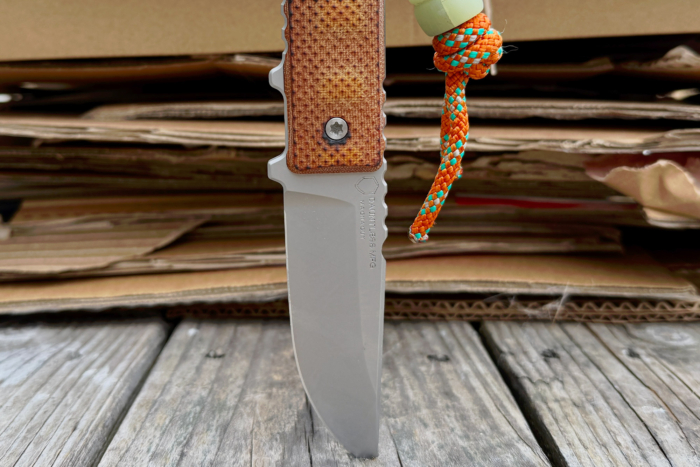Learn how to keep your pocket knife performing its best with this step-by-step guide.
A pocket knife is always a useful tool to have on hand — unless it has a dull edge. It’s important to sharpen your pocket knife regularly. This is how to sharpen the blade properly so you don’t risk damaging your knife.
Here, we compare advice from several knife manufacturers and experts so you can confidently sharpen your pocket knife. We cover what tools you can use to sharpen your knife, how to find the right angle to sharpen your knife, how to strop your blade, and how to test for sharpness.
With this knowledge, you never have to use a dull blade again.
How to Sharpen Your Pocket Knife
1. Select your tools.
First, it’s worth noting there are many knife-sharpening tools on the market. You can use a handheld travel sharpener, like Smith’s PP1 or Lanksy BladeMedic. Or there are slightly fancier setups like the Spyderco Tri-Angle Sharpmaker Set. We’ve tested and loved the Wicked Edge GO knife sharpener.
These tools in general help you maintain the angle of your edge while sharpening. Or, you can also use a simple sharpening stone. Professional knife-sharpener Peter Nowlan recommends a 1,000-grit whetstone. Many sharpening tools come equipped with a coarser-grit stone, best for use on very dull blades, as well as finer-grit stones for honing your blade.
Some stones require a lubricant such as mineral oil or water (whetstones); others don’t. Regardless, read the instructions of your tool, as each is slightly different.
2. Clean your pocket knife.
Now’s a good time to make sure your knife is clean. You can use soap and water to wipe the blade clean of dirt, grease, and any other residue. Make sure to dry it completely. It’s also good to check that there are no nicks in the blade, which might need extra attention when sharpening.
3. Find your edge angle (or edge bevel).
Every knife is a little different and has a specific edge angle. Your goal in sharpening is usually to match that angle unless you want to completely re-profile the knife. Victorinox, which makes Swiss Army knives, recommends sharpening at a 15- to 20-degree angle on both sides. Tools such as the Spyderco Sharpmaker are set at 15- and 20-degree angles.
If you want to keep the same angle that your knife came with from the manufacturer, you can always contact the manufacturer or find the information in your owner’s manual. If you’re using a sharpening stone, some experts, like Buck Knives, recommend using a marker along the edge before sharpening it. That way, you can tell you have the right angle after a couple of sharpening strokes when the ink is all removed.
4. Begin sharpening your pocket knife.
Here, it’s important to follow the instructions included in your sharpening tool. For a sharpening stone, place your blade on the stone and run it along the whole length of the blade, like you’re trying to shave off slices of the stone. Use a sweeping motion that ensures you’re making contact with the entire length of the blade.
Luckily, with a pocket knife, this is much easier to do than with larger knives because the blade tends to be shorter. Different sharpening tools require you to use slightly different methods to achieve this, but the end goal is that you’re using the abrasive material to remake the edge of your knife.
Bill Raczkowski of the American Knife & Tool Institute shared with us that, “It’s a very light grip and low pressure on the knife that’s best. Let the stone do the work; keep a constant angle and a constant pressure on the stone.” Consistency in holding the angle is key. Then, when you feel a burr of metal rising up along the blade, it’s time to switch sides (more on this below).














